The picture on a television screen is made up of thin lines of light. In the first project, you will see that a television picture is made up from rows of glowing dots of colored light. The picture consists of just three colors – red, green, and blue. Viewed from a distance, these colors mix to produce the full range of colors that we see naturally around us – as the second experiment demonstrates.
Fax machines work in a similar way to television, only more slowly. When you feed a sheet of paper into a fax machine, a beam of light moves back and forth across it. Dark places absorb the light, and pale places reflect it. The reflected light enters a detector that produces an electric current. The electric current is changed into a code made up of chirping sounds. These travel down the line to the receiving fax machine. This code controls a scanner that moves across heat-sensitive paper and produces a facsimile of the original. The final project shows how a fax machine breaks an image into tiny squares that are black and white.
YOU WILL NEED
- TV screen:
TV set, flashlight, powerful magnifying glass.
- Secondary colors:
Red, green, and blue transparent plastic sheet, 3 powerful flashlights, 3 rubber bands, black card.
- Digital images:
Ruler, pencil, tracing paper, photograph, black felt-tipped pen.
TV SCREEN
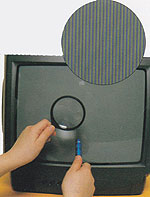 STEP 1
STEP 1
Turn off the TV. Shine the flashlight close to the screen and look through the magnifying glass. You will see that the screen is covered in very fine lines.
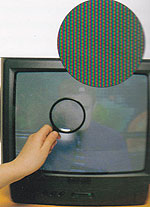 STEP 2
STEP 2
Turn on the TV and view the screen though the lens. The picture is made up of minute rectangles of light colored red, green, and blue.
SECENDARY COLORS
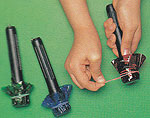 STEP 1
STEP 1
Attach a piece of colored plastic over the end of each of your three flashlights. Stretch the plastic tightly, and use a rubber band to hold it firmly in place.
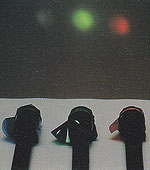 STEP 2
STEP 2
Shine the flashlights onto the black card. You can see the three different primary colors of red, green, and blue.
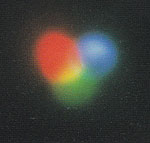 STEP 3
STEP 3
Position the flashlights so that the three circles of colored light overlap in a clover leaf pattern. Overlapping colors mix to give new, secondary colors.
DIGITAL IMAGES
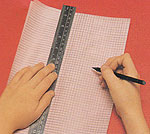 STEP 1
STEP 1
Draw a line ¼in apart to cover the tracing paper over the photograph. Use the pen to fill each dark square. Leave each light square blank.
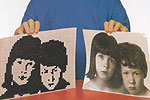 STEP 2
STEP 2
The result is a "digitized" image, which means it can be represented by numbers-the digit 1 for the white squares, and the digit 0 for black squares. The digitized image contains less detail than the original ph+oto. One could increase the details of the image by using a greater number of smaller squares.
Back to School Projects Main







 STEP 2
STEP 2